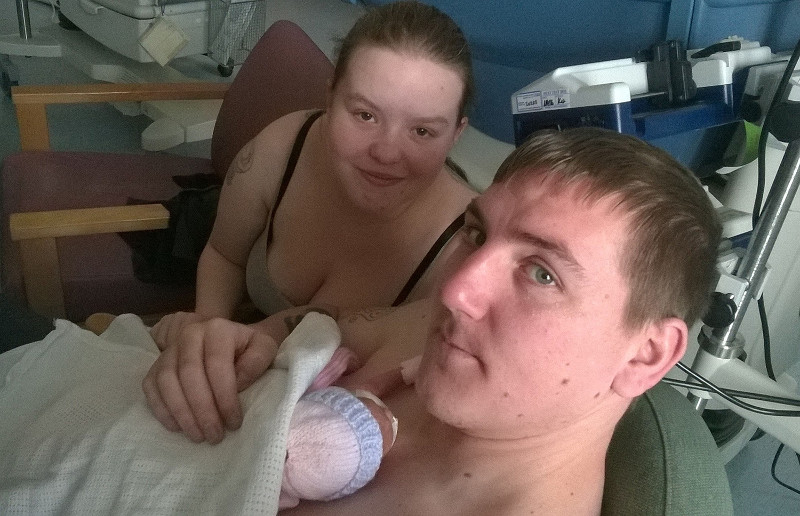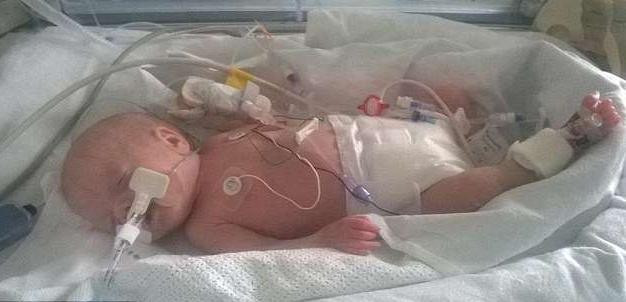Survival skills that everyone needs to know to save many lives
This is an emergency resuscitation skill used in an emergency.
Recently, a family in Grimsby (England) experienced a moment described as "horrible", when their newborn daughter almost disappeared away forever.
More specifically, Layla-Rose has a very weak health due to 3 months premature birth. After 2 weeks of discharge, suddenly the girl stopped breathing, her face turned pale, almost approaching death.
In that moment, Daniel Ward did everything he could to save his daughter. And the 27-year-old father was successful, all thanks to a new skill learned just a week ago: CPR - cardiopulmonary resuscitation skill.

Daniel Ward - who made a magical moment for his family.
Ward said: "I was very scared, but it was my daughter and I could not see it die. And then when she coughed and breathed back, it all broke, and I still couldn't believe it. If I had saved her life, if my previous week had not been studied CPR, our daughter might have died forever Everyone should learn this skill, because a life can be saved by it. ".

Layla-Rose - the girl saved by her father.
So in the end, how important is CPR? Why do people need to know about this technique?
CPR - Emergency resuscitation skills everyone should learn
CPR (Cardiopulmonary resuscitation) is an emergency resuscitation skill used in an emergency, with a combination of chest compressions and artificial respiration.
This is really a very important skill. When the victim's heart stops beating, the nose stops breathing, the oxygen supply is cut off. Without oxygen, the brain will suffer permanent damage and even lead to death within 8-10 minutes.

This is really a very important skill.
But if you do CPR properly, you can save the victim's life by restoring blood to the heart, brain, restoring the breath before the medical staff arrives.
The American Heart Association estimates this is a very important survival skill, everyone should know to be able to use it at any time.
When should CPR be performed?
The sooner CPR is performed, the more likely it is to save patients and not affect the brain. However, you cannot rush to save people who need to check the environment first.
Make sure your surroundings are safe: no open power, normal air, no toxic gas .
You will not be able to save people if you become a victim yourself. Next, consider whether CPR should be implemented.
For adults, it is possible to check by shaking your shoulders slightly, asking for reactions. Watch my pupils, listen to my breath and see if my chest is moving. If the victim is determined not to respond, immediately call for help, ask the person to call for emergency and then perform CPR.
If it's just you, call emergency before CPR , unless the situation is too serious like a drowning accident.
Basic instructions for emergency resuscitation
CPR has 3 basic parts, abbreviated as CAB . In which C (Compression) is chest pressed , A (Airway) is the airway, and B (Breathing) is artificial respiration.
However, experts recommend that if you have not undergone any emergency resuscitation training, just "C" is enough , because it is the simplest, easiest to carry out routine. High efficiency. That's why this article will only guide you to press your chest.
This chest compressions aim to restore blood circulation, help the heart beat and thereby restore other organs. First, put a flat layer of under the patient's back. After that, place your hand in the center of your chest, about 2 armpits.

Hand placed in the center of chest, under armpit.

Next, place the wristband on the center of the chest, then put the other hand on to support.
Finally, keep your elbows straight, use your entire body weight to press hard. According to the American Heart Association, chest compressions should be performed quickly, strongly and right in the middle of the chest, at a rate of about 100 times per minute. But for children, the movements will have to be a little lighter to avoid hurting the chest in children.
It should be noted that the chest compressions have to use a lot of strength so you can ask for an extra person - continue to work at a rate of 100 times / minute until the victim shows signs of recovery, or when a doctor , medical experts come.
Such continuous chest compressions to force the heart to contract to supply blood to the brain. Although the victim begins to show signs of breathing again, continuous chest compressions should continue for a while longer.

If you haven't gone through any CPR class, keep doing this until the victim has a reaction, or medical experts appear.
For airway and Breathing steps, you should take a CPR training course. There, you will learn how to put the victim in the right position, how to clear the airway when there is a blocked object, and how to effectively breathe.
These are very difficult steps to describe without direct instruction, and may have unintended consequences, so the article will not mention.
Learn CPR to prevent uncertainty
In Vietnam, CPR training courses are not yet universal in schools, but hospitals or Red Cross sometimes organize these courses. If you want to join, you can contact these organizations for more information.
- 10 survival skills for lost forest goers
- Under these 5 vital skills, you may not be hungry, thirsty, cold and drowned!
- 10 skills 'wish' we are taught at school
- 9 word-of-mouth survival tips can make you more likely to die
- How to survive the apocalypse?
- Memorize this 6 self-defense tips to prevent the occurrence of uncertainties
- Survival skills when buried alive in coffins
- Safety skills to survive when cars suffer from traffic accidents
- 6 survival secrets can save your life every time a thousand pounds of hair hanging
- Survival tips: How to cut the rope when there is no cutlery
- Pocket immediately these 5 skills to prevent any uncertainties
- Wrong survival tips on movies, never follow
 Green tea cleans teeth better than mouthwash?
Green tea cleans teeth better than mouthwash? Death kiss: This is why you should not let anyone kiss your baby's lips
Death kiss: This is why you should not let anyone kiss your baby's lips What is salmonellosis?
What is salmonellosis? Caution should be exercised when using aloe vera through eating and drinking
Caution should be exercised when using aloe vera through eating and drinking